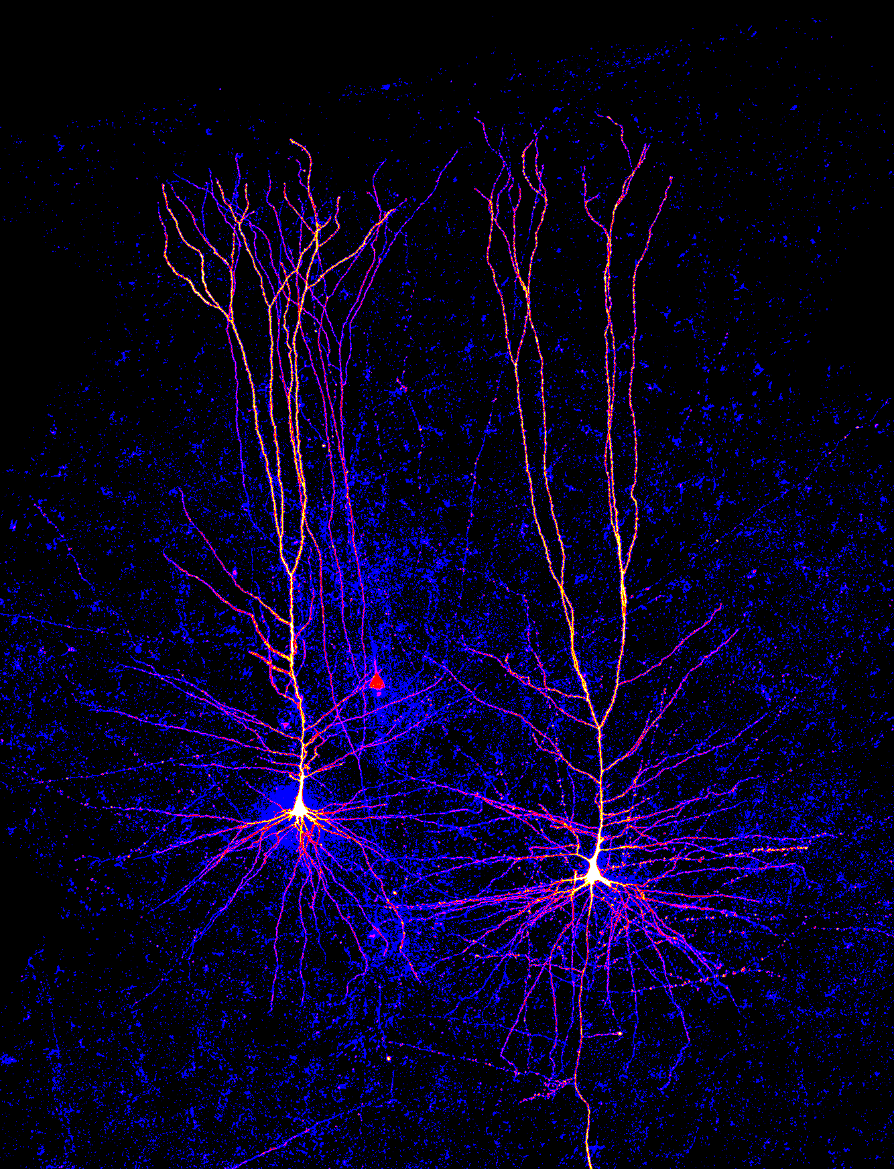- Feature
The redwoods of the cortex
13 January 2023
In dealing with the world’s dynamic, complex, ever-changing nature, the complexity of the brain does not fall short of the complexity of the world. Brain complexity can be found across all its levels, from its network function down to the level of single brain cells (and beyond).
Human Brain Project scientist Matthew Larkum has led the Neuronal Plasticity laboratory at the Charité Medical University campus in Berlin since 2011. His research focuses mainly on single brain cells and their computational properties. Since his postdoc studies under Nobel laureate Bert Sakmann back in the late 1990s, Larkum’s findings have led him to propose that the computational properties of single brain cells are much more complex than commonly appreciated. Instead of neurons being simple binary devices, such as machine learning algorithms typically assume that they are, they operate simultaneously on tens of thousands of synaptic inputs, all distributed over the dendritic tree1. In fact, his work suggests that a single neuron’s computational complexity has far-reaching implications for perception and even consciousness.
Larkum’s main focus is on the properties of pyramidal neurons, the brain cell type that is located exclusively in the cerebral cortex.
Larkum: “The pyramidal cell type is really extraordinary in every sense. I think you only have to look at its shape and position in the cortex, as was already shown in the early drawings of Santiago Ramón y Cajal, who was himself convinced of their extraordinary nature.”
“It’s like a great big redwood tree. It has a very long trunk with roots at the bottom, which are dendrites coming out of the cell body. And it has tuft dendrites at the top, which look like tree branches collecting sunlight.”

Comparable to a tree, which absorbs water at the bottom and sunlight at the top, the tree-like architecture of a pyramidal neuron would give it an analogous top-bottom division of tasks. In the case of the pyramidal neuron, these tasks would involve, roughly speaking, the processing of feedforward information at the bottom and feedback information at the top.
Feedback and feedforward processing are terms that together take up an important place in the ‘predictive coding’ theory of the brain, which proposes that the brain’s ultimate function is to continually update its expectations and predictions of the world in accordance with sensory information or ‘reality’. Here, feedback information streams process the predictions and feedforward streams the incoming sensory data.
Trying to figure out how feedback is processed in the cerebral cortex, is how Larkum first got involved with the Human Brain Project. With his expertise in recording from the tiny branches (dendrites) of pyramidal neurons, he started bringing the two processing directions together.
Larkum: “We observed that a single pyramidal neuron has special electrical properties to handle both information streams, feedback and feedforward, and combine them, in ways that are easy to demonstrate once you have the equipment and technical know-how.”
“I hypothesize that feedback and feedforward processing, instead of only operating on a network level, are brought together and coupled at the cellular level, with the feedback information arriving at the tuft dendrites at the top of the tree, and feedforward at the bottom of the tree.”
To test the role of this coupling in the act of perception and consciousness, Larkum’s research team artificially activated the tuft dendrites of cortical layer 5 pyramidal neurons by simulating feedback input2. In awake mice, this stimulation was transmitted down the trunk of the tree to cause activation at the cell body, near the bottom of the pyramidal neurons. However, when the mice were anaesthetized, activating the tuft dendrites had no effect on the output of the neurons, showing that anaesthesia prevents feedback inputs to the top of the tree from influencing the output of the neuron by somehow blocking information flow down the tree trunk.
Larkum: “The reason for the unconscious state under anaesthesia here would seem that the cortex can no longer process feedback information, and therefore there is no perception, and therefore there is no consciousness. By pushing this a bit further, in the same study we demonstrated that projections from the higher order thalamus played a role in maintaining the flow of information down the tree trunk. This might finally make sense of apparently contradictory observations by different laboratories, some claiming that the main effect of anaesthesia is to reduce the influence of feedback within the cortex, and others claiming that it suppresses the thalamus.” If, as Larkum’s team demonstrated, the thalamus regulates the influence of feedback within cortical neurons, this would neatly explain the other two laboratories’ observations.
In another study as part of the Human Brain Project, Larkum and his colleagues compared the computational properties of pyramidal neurons in rodents with those in humans. This led to his discovery of a new type of ion channel in the tuft dendrites of pyramidal neurons in layer 2/3 of human cerebral cortex3, which incidentally is proportionately thicker in humans than in any other species, suggesting that there might be something unusual and special about human cortical layer 2/3.
Larkum: “Although nearly all work done in this field so far has been on rodent dendritic properties, we found that the properties of the human neurons are even more interesting. We were able to record spikes from human dendrites and show that these can change the input to output function of the neuron in ways not possible in rodent neurons.” In line with these observations, he recently published an extensive review on the cross-species phenomenon of cortical dendritic spikes4.
Although the research findings and conclusions are persuasive, the view that single pyramidal neurons and their dendrites can solve complex computations is not (yet) commonly accepted or even considered in neuroscience theories.
Larkum: “Many researchers still ignore dendritic spikes. Perhaps because they think it’s an irrelevant complication, not necessary to take into account.”
Understanding more precisely how these complex cells actually behave does have implications: the main pyramidal neurons, for example, those that are located in the deeper cortical layers 5 and 6 and provide output from the cortex to other subcortical structures, actually do not seem to be performing the kind of ‘predictive coding’ that is currently a leading theory of neocortical function. As may be expected, for proponents of the predictive coding theory, it is difficult to reconcile the emerging picture with this theory.
Larkum: “I claim that these deeper pyramidal neurons are built such that if what is expected matches the incoming data, this leads to a huge burst of activity in these neurons. This is actually the inverse of predictive coding, according to which neurons become active when there is a mismatch. On the other hand, I think this issue can be reconciled by contrasting the operation of deep pyramidal neurons with superficial ones, which do, in fact, seem to operate according to predictive coding. As usual, the biology is more complex than our theories.”
“It makes a big difference to treat neurons as complex computational devices, and it is absolutely necessary to take their sophistication into account if we want truly to understand the brain.”

Prof. Matthew Larkum works in the ‘Consciousness & Cognition’ focus area (work package 2) of the Human Brain Project. You can find his biography and publications here.
Text by Matthijs de Boer
References
1ME Larkum. Are dendrites conceptually useful? Neuroscience. 2022 May 1;489:4-14.
2M Suzuki, ME Larkum. General anesthesia decouples cortical pyramidal neurons. Cell. 2020 Feb 20;180(4):666-676.e13.
3A Gidon, TA Zolnik, P Fidzinski, F Bolduan, A Papoutsi, P Poirazi, M Holtkamp, I Vida, ME Larkum. Dendritic action potentials and computation in human layer 2/3 cortical neurons. Science. 2020 Jan 3;367(6473):83-87.
4ME Larkum, J Wu, SA Duverdin, A Gidon. The guide to dendritic spikes of the mammalian cortex in vitro and in vivo. Neuroscience. 2022 May 1;489:15-33.



